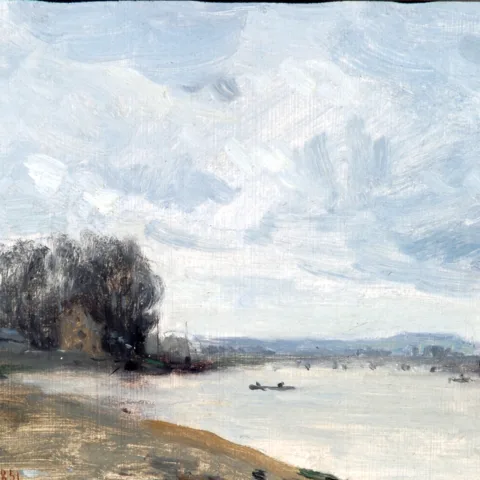The Bowes Museum Blog

Eugène Boudin
“Everything that is painted directly and on the spot has always a strength, a power, a vivacity of touch which one cannot recover in the studio…” Eugène Boudin

Boudin, Eugene Louis; Beach Scene at Low Tide; The Bowes Museum
Eugène Boudin: Painter of Modernity
Considered as one of the first painters who worked in the open air, Eugène Boudin was a French artist who developed a personal style close to both traditional painting and the new 19th-century Impressionist manner. Born in Honfleur in 1824, he was used to the marine environment since he worked in Le Havre, a famous port city in Normandy located in the North West of France. Rapidly Boudin ventured to leave his studio and explored the opportunity to paint outdoors and observe what surrounded him. This is what we call ‘outdoor painting’, and several painters famously employed this technique, such as Berthe Morisot, Edouard Manet or Pierre Auguste Renoir. What fascinates them was the fugitive light, the morning dew and the light evening mist. In short, they were looking for the ephemeral.
Visibly inspired by the diversity of nature, Boudin loved to paint the Normandy coast and its beaches which were frequently visited by the rich Parisians who reached Trouville and Deauville from the Gare Saint Lazare in Paris. At the time, Deauville became famous for its bathing facilities. During his career Boudin painted in a variety of places characterised by a ‘capricious’ atmosphere: he was passionate about the stormy skies and those fleeting beams of light that penetrated into the black sky. However, he also painted clear skies in shimmering colours.
Eugène Boudin: a Philanthropic Painter
Beach scene at low tide is a painting the artist executed in 1867. It is an excellent illustration of the whole production of Boudin and in my opinion it seems to reveal many aspects of his personality. Unsurprisingly, Boudin painted his characters action, without posing. Elegant ladies with their open parasols stand by gentlemen who come to life under Boudin’s very thick brushstrokes. The painter seemed to cherish his models as much as he cherishes humanity. Although the faces of these young ladies are melted in coarse paint patches, nevertheless they are filled with benevolence, freshness and tenderness.
Eugène Boudin: Painter of Maritime Views
Boudin shows his original style when he depicts the crowd of characters captured in their daily routine. However, the figures are only a pretext to paint the seaside. By looking closely at the painting, we can see how Boudin devoted the majority of the painted surface to the representation of the sky, and the overall splendour of his images is enhanced by the elegant and colourful dresses. Thanks to his skies, sometimes striking for their yellow and vivid light and also the white and soft tones, Boudin was nicknamed “The King of the Skies” by his fellow artists. Charles Baudelaire, a famous French poet and close friend of Boudin, stated: ‘While looking at a painting of Boudin, one can guess the season, the time and the wind …’
At the centre of the composition, Boudin places a lady dressed in a blue gown rendered with a pure and light blue colour. Other female figures in the composition, standing or sitting down, attract our attention. Similarly, our eye gets caught by a puddle of water that the sea has left before retiring. This is another device used by the painter to reflect the cloudy sky, weighed down by the rain and which lets us imagine the fresh and foggy atmosphere of the moment.
Despite his outstanding skills as a painter, it was not easy for Eugène Boudin to gain a good reputation within the very privileged circle of the French bourgeoisie. Even if he was supported by his friends, his paintings were not praised by the wealthy clients of Deauville, who did not wish to see themselves represented in such a fuzzy and imperfect way. Boudin gradually abandoned the bourgeois scenes and moved to subjects depicting beaches and fishermen, whom he painted with great virtuosity. Eventually, he was acknowledged as the “Painter of marines.”
Boudin, who vivified the seascape using a simple brushstroke and who was, in my opinion, the best interpreter of the ‘caprices’ of the sky, was without any doubt able to deeply inspire his successors, the Impressionists, such as Claude Monet. Moreover, he left an indelible mark in the history of painting making Normandy even more beautiful to our eyes.
By Marie Ceffrey, Curatorial Intern, Paris-Sorbonne University







